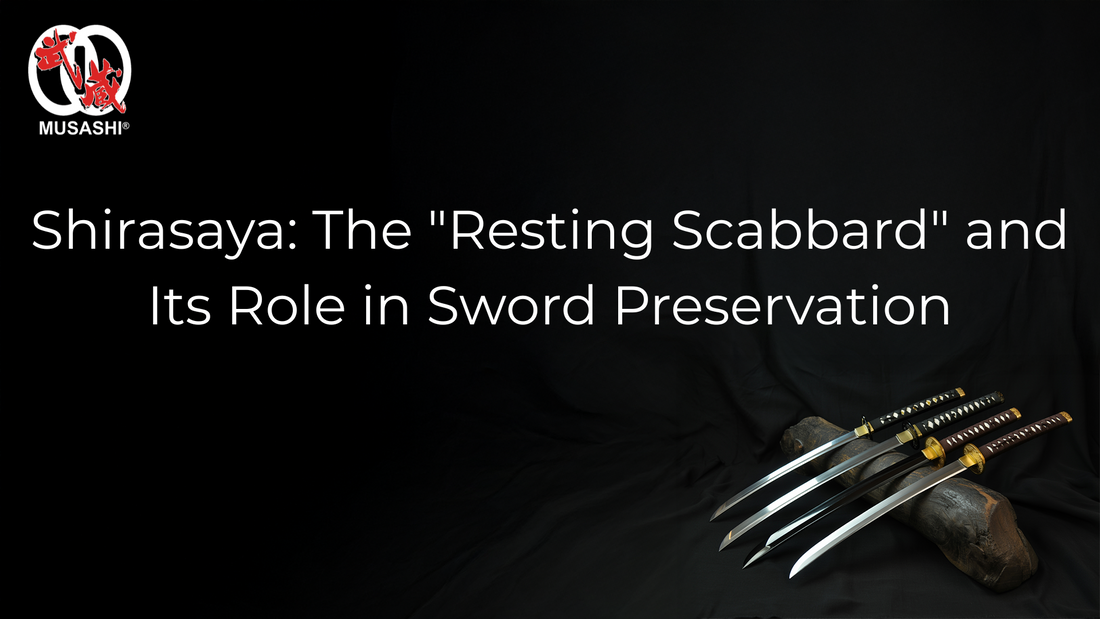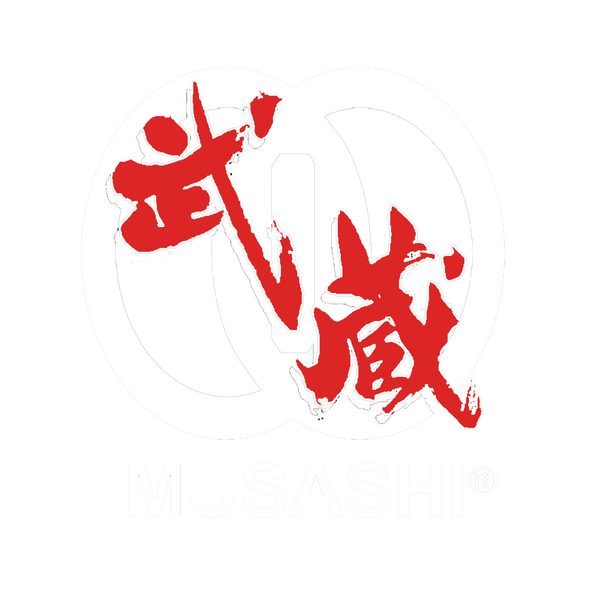
Shirasaya - The "Resting Scabbard" and Its Role in Sword Preservation
Share
Shirasaya - The "Resting Scabbard" and Its Role in Sword Preservation
Shirasaya - The "Resting Scabbard" and Its Role in Sword Preservation plays a vital role in protecting Japanese katana and antique tanto blades during blade restoration by Musashi Swords. This practice helps maintain the integrity of signed blades like the Hizen no Kuni Yoshisada, ensuring their longevity and preventing damage from moisture or rust.
What is a Shirasaya? The Resting Scabbard for Japanese Swords
A Shirasaya is a plain wooden scabbard made for Japanese swords. It isn't fancy like other sword mountings. Instead, it's simple and smooth. People use it as a resting scabbard to keep the blade safe when not using the sword.
Here's what makes a shirasaya special:
- Material: It's usually made from good-quality wood that lasts long.
- Design: Plain and plain, no decorations or flashy parts.
- Functionality: It protects the blade from dust, moisture, and other things that might hurt it.
This plain sword sheath helps keep swords safe and works well with different sword mounting styles. It's like a quiet guardian for your blade.
Preservation and Tradition in Japanese Swordsmithing
The shirasaya has a strong place in history. It first showed up in the Edo period, which lasted from 1603 to 1868. During that time, samurai culture was big, and sword making was serious business.
Some facts about its cultural heritage:
- Crafting shirasayas uses old-school methods passed down through families.
- They show respect for the sword maker's art by staying simple instead of flashy.
When you put your sword in a shirasaya, you honor both the blade and centuries of samurai tradition. This link to old times makes the sword even more special for collectors or martial arts fans.
Shirasaya's Role in Protecting Antique Blades
Keeping old blades safe takes care and attention. That's why shirasayas are so useful. They protect swords when they're not on display or being used.
Here's how they help:
- Blade Protection: They stop scratches and bumps from messing up the blade.
- Rust Prevention: They cut down moisture that causes rust on steel blades.
- Avoiding Blade Tampering: They keep the blade tucked away so no one fiddles with it by mistake.
In short, combining a shirasaya with regular sword maintenance practices from our collection ensures your antique blade remains safe and in optimal condition. This way, the sword stays in good shape while showing respect for Japanese history and culture at the same time.
Shirasaya Construction Techniques - A Look at Traditional Craftsmanship
The shirasaya is a plain wooden scabbard made mainly to keep swords safe, not for fighting. It shows the skill of Japanese craftsmanship that values simplicity and function. Craftsmen shape each shirasaya by hand. They use woodcraft skills passed down for many years. Unlike fancy koshirae mountings, the shirasaya's job is to protect the blade from moisture and damage when it's stored. The wooden scabbard must fit the sword tang (nakago) just right. If it moves, it could cause scratches or rust. This fit needs careful woodworking and knowledge about swords.
Japanese makers pick wood with fine grains. Smooth wood means less friction on the blade. They sand and polish carefully, sometimes adding a little oil. This makes the shirasaya strong but still lets the blade breathe a bit. That way, the steel stays safe without damage In short, making a shirasaya blends art with old traditions. Every small step has a clear purpose to take care of swords in the best way.
Materials Used in Shirasaya - Wood Selection and Its Importance
Choosing the right wood is key to making a good shirasaya. It affects how strong and protective the scabbard will be. Traditionally, simple woods that resist humidity are best for these plain wooden scabbards.
Here are common woods used:
- Honoki (Japanese magnolia): Strong and stable. It has low resin, so it won't scratch blades easily. It also lets air move around the blade, which helps stop rust.
- Kiri (paulownia): Light wood with some resistance to moisture. People pick it when they want something easy to carry.
- Sugi (Japanese cedar): Has a smell but is more porous. Not as good if you want full protection from moisture.
Each wood type offers different benefits depending on where it's from and what's needed.
Picking the right wood keeps a shirasaya tough but gentle on blades for many years. Using natural materials this way helps keep old Japanese swords looking great while protecting them well.
Shirasaya vs. Other Sword Mountings
Comparing Shirasaya to Koshirae: Key Differences and Purposes
Shirasaya is a plain wood scabbard. People use it mainly as a resting scabbard for Japanese swords. Unlike the fancy koshirae, shirasaya keeps things simple. Koshirae is the traditional Japanese sword mounting meant for display and battle use. Shirasaya protects the blade while it's stored or moved around.
The main job of shirasaya is to replace the sword's usual mounting when it's taken off. It acts as an auxiliary sword housing that stops moisture from building up. This helps avoid damage by letting air flow around the blade. Shirasaya usually uses unfinished magnolia wood. That way, no chemicals touch the steel, keeping it safe over time.
Koshirae, on the other hand, has many decorative parts. These include a lacquered saya (scabbard), tsuka (handle) wrapped with ray skin and silk cords, tsuba (guard), habaki (blade collar), and other fittings. These parts serve both looks and function. They show samurai status and make sure the grip feels secure during use.
Here's a quick comparison:
-
Shirasaya
- Plain wooden scabbard
- Used mostly for storage or resting
- Protects blade from rust but allows air flow
- Simple, elegant, timeless design
-
Koshirae
- Full traditional mounting with many fittings
- Made for battle or ceremonial wear
- Decorative with lacquered saya and wrapped handle
- Shows craftsmanship and samurai tradition
Knowing these differences helps collectors understand why swords often come with both mountings. Koshirae shows off or lets you wear the sword. Shirasaya keeps blades safe when not in use.
Caring for Your Shirasaya - Proper Storage and Maintenance
Taking care of your shirasaya matters just as much as caring for the sword itself.
Cleaning and Inspection
Wipe your shirasaya regularly with a soft cloth. This removes dust and dirt that can build up. Look closely for cracks or warping. Damage like this can stop it from protecting the blade properly.
Storage Conditions
Keep swords inside their shirasayas in places with low humidity. High moisture can cause rust on blades even when stored carefully. Cool, dry spots away from sunlight work best.
Recognizing Rust Types
Knowing different kinds of rust helps you spot problems early:
- Black Rust: A stable, harmless oxidation layer often found on older blades.
- Red Rust: Active rust that spreads fast and needs fixing right away.
- Active vs Passive Rust: Active rust grows quickly; passive rust stays still but should be watched.
To stop rust forming inside the shirasaya, our katana maintenance service offers expert tips on applying the right oils to keep your blade in pristine condition. Sewing machine oil works well because it's pure and won't gum up A tough, well-made shirasaya adds another layer of defense for your sword. Together with cleaning and proper storage, it keeps samurai blades safe from damage over time.
The Enduring Legacy of the Shirasaya - A Timeless Tradition
The shirasaya, known as the "resting scabbard," helps protect samurai swords when they are not used. It is made from plain, high-quality wood. This type of scabbard is simple but very useful. Its main job is to keep the blade safe from moisture and damage.
This traditional piece shows expert knowledge and craftsmanship from Japan. The shirasaya looks plain but carries a lot of respect and history. Its design makes storing swords easy and keeps them from rusting or bending. Many people see the shirasaya as more than just a tool. It honors samurai heritage by keeping blades in great condition for the future. It combines practical protection with cultural meaning.
Its Value to Collectors and Enthusiasts
Collectors appreciate the timeless quality of a shirasaya, much like the enduring beauty and craftsmanship showcased in our range of authentic katanas that honor centuries of tradition. These scabbards add more than just money—they bring artistic value too. The simple style shows skill and respects samurai culture.
A well-kept shirasaya helps prove if a sword is genuine during verification checks. Authentic resting scabbards keep cultural reverence alive for those who love samurai history. Owning these items also connects fans with Japan's samurai past. It builds respect for both the art and accuracy of swords over time.
FAQs
What is the main purpose of a shirasaya scabbard?
A shirasaya scabbard mainly protects the sword blade during storage and restoration. It prevents rust and damage by controlling moisture and dust.
How does shirasaya help in sword maintenance?
Shirasaya keeps blades safe from corrosion and scratches. It supports proper sword storage and aids experts during polishing or restoration.
Why is wood choice important for shirasaya?
Wood like Honoki offers durability and low resin content. It reduces friction, allows airflow, and limits rust formation on steel blades.
Can shirasaya prevent blade tampering?
Yes, shirasaya safely houses the blade, preventing accidental handling or tampering when the sword is not in use.
What makes shirasaya different from koshirae mountings?
Shirasaya is plain wood for resting; koshirae includes decorative fittings for display or combat use.
